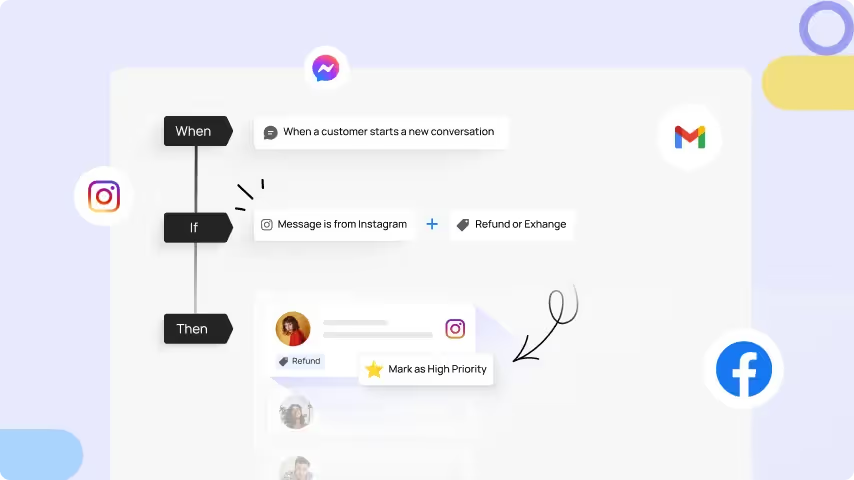
Attrition during the BFCM season is the last thing one would want to handle as a customer service head. But one can’t rule out the possibility of the same. It’s not an easy gig, and it’s not for everyone. The holiday rush makes it a few notches more difficult for support agents.
It’s imperative for CX leaders to spend enough time in agent enablement. The enablement includes tech stack investment, setting up automation workflows, clearly planning out assignment & tagging logic, and setting up enough training sessions to ensure consistency in the CS process.
No one enjoys burnout. The implications of burnout are harder on the agents and your customers. In this chapter, we have compiled a checklist of actions that CX leaders should ensure before going into the BFCM/ holiday season.
1. Customized Agent Views; One Window to Rule them All
A well-organized agent dashboard is arguably the best productivity hack for your support team. Sort out the basics, such as having a unified multichannel inbox and enabling collaborative conversations.
If you haven’t invested in an E-commerce CRM/helpdesk, now would be the best time to make the switch. Such systems would ensure no toggling of tabs between your E-commerce platform and helpdesk. Imagine the time saved if the agents could access the entire order history of the customer they are interacting with. Even better, if they have access to do basic order actions such as returns, cancellations, and re-orders without moving out of the helpdesk window.
Additionally, customize your customer profile with the most helpful information, such as the last order, frequency of shopping, last refund issued, and other pertinent information, so the agents can contextualize the conversations.
Simplifying the views for each agent or group of agents can help your team power through the tickets. Here is a list of customizable views to help agents prioritize and close tickets faster.
- Query-based views; Refunds and returns can take the highest priority.
- Channel-specific views; To give instant channels such as live chat and phone support immediate attention.
- Views for review management; React to negative reviews with a specific focus.
- Product-specific views; create views to tackle queries around similar products or product groups.

2. Assignment Rules and Smart Tagging
Time spent creating factions in the team and assigning specific roles will exponentially reduce the resolution times and increase agent efficiency. Particularly around the BFCM/ holiday season, context switching is a paramount expectation from your agents.
Create micro-pods in your team and assign them specific nature of queries. A combination of channel-based and query-based segmentation could also be explored to ensure the SLAs of each channel are maintained.

3. VIP Treatment for your Premium Customers
The holiday season could be a make-or-break season for building customer loyalty. It would hurt to lose your regular and premium customers because of the sudden spike in ticket volumes.
Every customer deserves a best-in-class experience, and the ones who drive up your AOV and revenue deserve a little more. Create an automation rule to single out conversations from premium customers based on the order value and assign them to your most trusted agents.

4. Social Media Monitoring
Distractions deserve no space, and social media is the most significant source of distraction. Social media channels have become mainstream support channels for E-commerce brands. But separating signal from noise continues to be a major problem for CS teams.
With promos, discounts, and coupons flying around, you should expect your social channels to buzz every few minutes. Some are going to genuine queries that deserve an agent’s time; the rest could be consumers sharing their love or becoming evangelists of your brand on socials. To avoid combing through the clutter, create an automation rule that identifies the query's intent from social media and only routes genuine customer problems to the support team. The rest can be directed towards the marketing team to engage and bolster the engagement.

5. Warranties and Damage Claims
We discussed the need for micro-pods earlier. One such critical pod would be to process your damage and warranty claims. A casual oversight might cost you a lot of logistical damage and needless confusion for your operations team and the customer.
Auto-tag the damage and warranty requests and route them to the warranty team, who would be enabled with the appropriate procedure to handle them.

6. Automate the Mundane through Macros
If you are struggling to get your team to adopt macros and shortcuts, there wouldn’t be a better time. Your support team would find their new best friend in the form of these templates and macros that will cut short their time to sift through basic queries.
Create macros for all common scenarios. If you are using a tool like Richpanel, you would be able to pull in personalization tokens from Shopify, Magento, or any E-commerce cart platform. This would ensure the customers receive personalized treatment without buring out your agents.

7. Review Management
There would be enough firefighting during the holiday season. You wouldn’t want one more in the form of bad reviews tanking your sales. Instantly act on bad reviews and convert them into a successful sale.
Having a SWAT team to act on the reviews would be ideal. Create a separate view to stay on top of new negative reviews. If you are using a reviews app, connect that with your helpdesk and create tickets for all the negative reviews. Create SLAs and guidelines to act on these reviews. It’s crucial to ensure consistency on these issues as the brand reputation is at stake.


